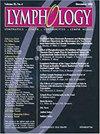在前瞻性筛查的乳腺癌患者队列中,基于流量计的体积臂测量和生物阻抗谱用于早期识别淋巴水肿的比较。
IF 0.7
4区 医学
Q4 IMMUNOLOGY
引用次数: 2
摘要
乳腺癌相关淋巴水肿(BCRL)影响着五分之一以上接受乳腺癌治疗的女性,并且女性仍处于终身风险之中。一些国家和国际组织建议对有BCRL风险的妇女进行BCRL筛查,并且存在多种客观筛查测量方法。本研究的目的是比较138名前瞻性筛查患者中使用血液测定法和生物阻抗谱(BIS)早期识别BCRL的情况。在每次筛查时,使用BIS计算患者的相对容积变化(RVC)和L-Dex从基线的变化(ΔL-Dex)。RVC与ΔL-Dex的相关性可忽略不计(r=0.195)。检测BCRL的多个阈值:RVC≥5%、≥10%,ΔL-Dex≥6.5、≥10。虽然一些患者出现RVC和ΔL-Dex升高,但许多患者仅表现出一种阈值类别的升高。此外,大多数RVC≥5%、ΔL-Dex≥6.5或ΔL-Dex≥10的患者在没有干预的情况下回归到非升高的测量。这些发现提示多种筛查方法的结合对BCRL的早期识别具有重要作用;此外,BCRL的诊断必须结合患者的症状和临床评估,以及通过渗血术和生物阻抗谱等技术获得的客观测量结果。本文章由计算机程序翻译,如有差异,请以英文原文为准。
Comparison of perometry-based volumetric arm measurements and bioimpedance spectroscopy for early identification of lymphedema in a prospectively-screened cohort of breast cancer patients.
Breast cancer-related lymphedema (BCRL) affects more than one in five women treated for breast cancer, and women remain at lifelong risk. Screening for BCRL is recommended by several national and international organizations for women at risk of BCRL, and multiple methods of objective screening measurement exist. The goal of this study was to compare the use of perometry and bioimpedance spectroscopy (BIS) for early identification of BCRL in a cohort of 138 prospectivelyscreened patients. At each screening visit, a patient's relative volume change (RVC) from perometer measurements and change in L-Dex from baseline (ΔL-Dex) using BIS was calculated. There was a negligible correlation between RVC and ΔL-Dex (r=0.195). Multiple thresholds of BCRL were examined: RVC ≥5% and ≥10% as well as and ΔL-Dex ≥6.5 and ≥10. While some patients developed an elevated RVC and ΔL-Dex, many demonstrated elevations in only one threshold category. Moreover, the majority of patients with RVC ≥5%, ΔL-Dex ≥6.5, or ΔL-Dex ≥10 regressed to non-elevated measurements without intervention. These findings suggest a role for combining multiple screening methods for early identification of BCRL; furthermore, BCRL diagnosis must incorporate patient symptoms and clinical evaluation with objective measurements obtained from techniques such as perometry and bioimpedance spectroscopy.
求助全文
通过发布文献求助,成功后即可免费获取论文全文。
去求助
来源期刊

Lymphology
医学-免疫学
CiteScore
5.20
自引率
8.00%
发文量
29
审稿时长
3 months
期刊介绍:
The Journal contains original articles, special features (see below), and information regarding the International Society of Lymphology. It seeks original papers dealing with clinical and basic studies of the lymphatic system and its disorders including related fields. Articles are accepted for external review and publication on the condition that they are contributed to Lymphology only and that no substantial part has been or will be published elsewhere.
 求助内容:
求助内容: 应助结果提醒方式:
应助结果提醒方式:


